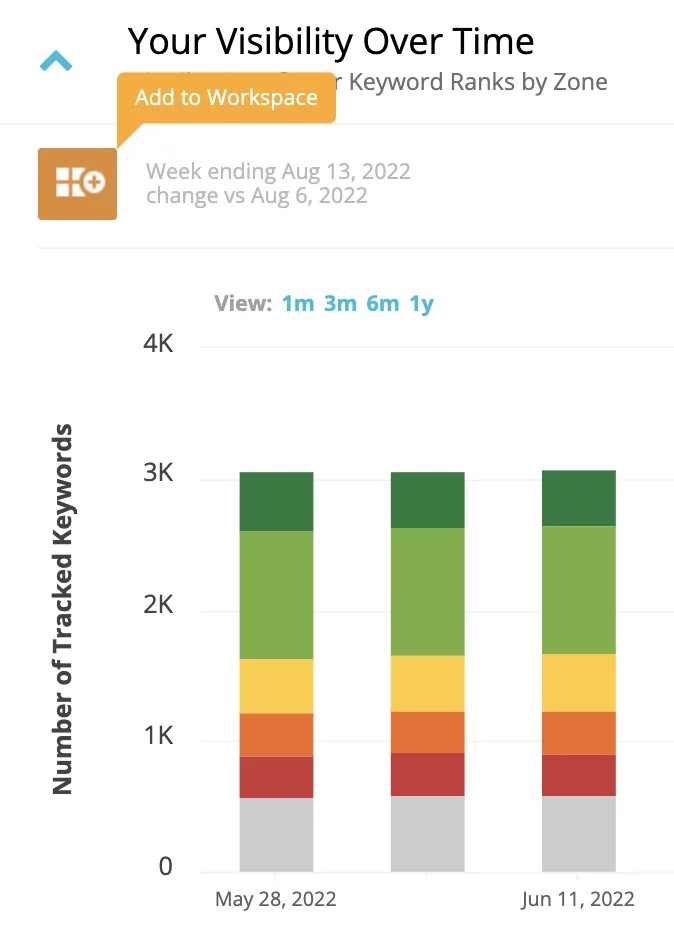Content Findability: How Do I Ensure My Content Gets (and Stays) Found?
Content is a business asset, like any other. It should be inventoried, tracked, and optimized. Improve the value of your new and existing content with these tips.
Content is a business asset, just like any other. It should be inventoried, tracked, and fixed if it’s not functional. Despite this common sense idea, businesses tend to produce content without a plan for its future. And in some cases, content is created without a clear vision of what it can offer in the present.
Use Conductor to achieve these results.
The potential ROI of your quality, findable content is high when you do it right. This type of content can drive traffic to your website immediately and for years to come. With a strong keywordKeyword
A keyword is what users write into a search engine when they want to find something specific.
Learn more strategy, the right topic focus, and informational content, you could be well on your way to SEO success.
While, in theory, quality content can last forever, Google rankings don’t always follow suit. Even though your content has the potential to provide value for years to come, it might not be found by searchers for as long as you think. RankingsRankings
Rankings in SEO refers to a website’s position in the search engine results page.
Learn more are constantly changing as search engines update their algorithms and search trends change.
We have a problem with excess and unregulated content
With all the talk of the need for quality, findable content across industries (e.g. eCommerce, Sales, SaaS, Advertising) and roles (e.g. Content Marketers, Copywriters, SEOs, Digital Marketing Leaders), many marketers react by going into what we call a content frenzy. That is, they produce as much content as possible and hope it gets traction, but there is no systematic targeting or measuring in place. If the content gets visibility and traffic, that’s great. If not, it sinks, forgotten, to the bottom of the blog roll or unvisited portions of the site.
Findable content can eventually become dated and out of sight
These companies end up with a content iceberg—they have a little bit of content that is visible and recognizably useful, but the vast majority of it is out of mind and out of sight. The previously findable content grows outdated and loses relevancy. It becomes hoarded excess that they should either throw out or revitalize.
The image below is a view from Conductor’s Content Insights. The deep green color is the top of the iceberg—content with high visibility. The gray portion represents content that has no traffic at all. The proportions here (the gray being many times the size of the green) are common for a site that has not been systematically optimizing content. As you can see, most of the content on this site is not delivering value.
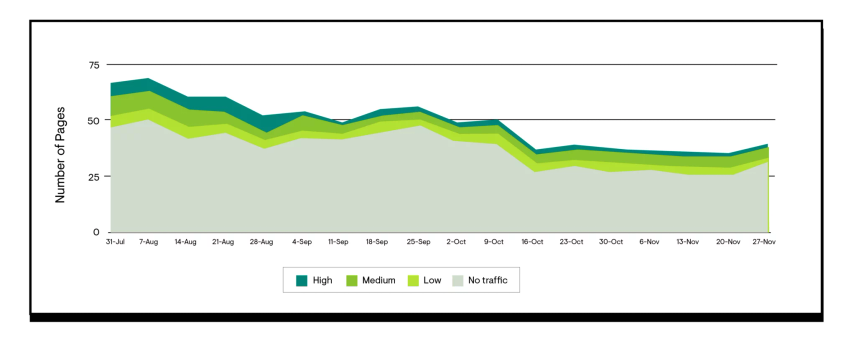
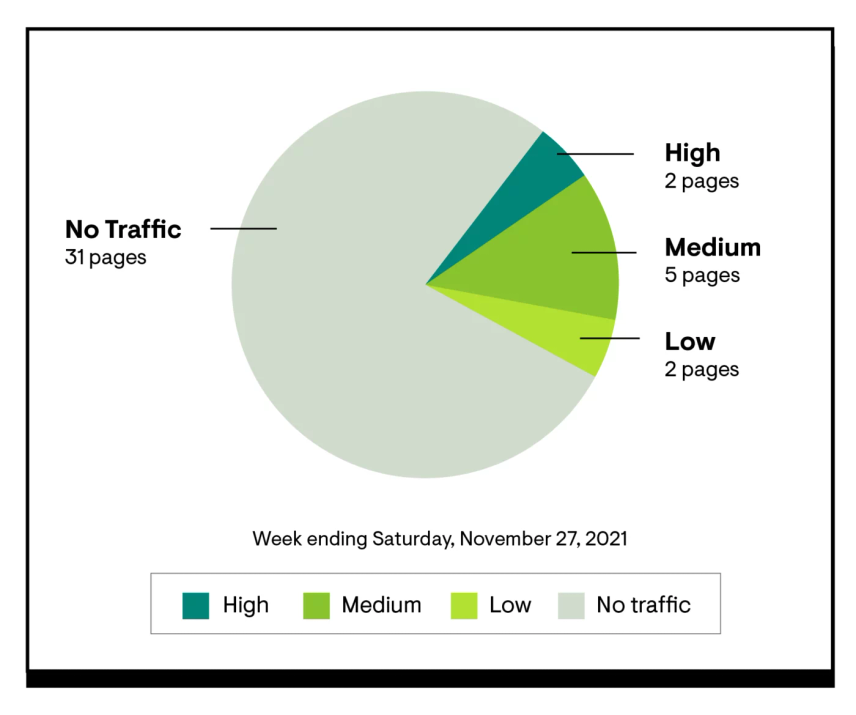
Device and location affect your website’s findability and how high you rank
This problem of website findability is complicated by the growing number of ways we can look at content. Your device and location affect how visible your content is. You might have content that ranks well when you type a query into your desktop, but the same piece doesn’t appear on your mobile device.
The strategy “If I write it, they will come” isn’t enough to get ahead in your digital vertical. Social promotion and syndication help with that initial push, but don’t provide tactical insight into the content’s lifecycle. So, what do you do?
Issues with content findability: 3 reasons your content isn’t being found
If you’re starting with a backlog from your content frenzy days, the first thing you need to do is to get your bearings. Determine what content you have and measure its efficiency.
Run a content audit to discover which pages are receiving traffic and how much of it? In what instances (consider the effects of different search engines, devices, and locations) is content visible in search, and for what keywords? You’ll want to know the status of your content on an ongoing basis to protect the successful content assets you have and optimize the ones that are faltering.
Google has a checklist for appearing in search results , which lays out a few questions to ask yourself, including a few notables:
- Do you serve high-quality content to users?
- Is your content fast and easy to access on all devices?
- Is your website secure?
- Is your content about a specialized topic or series of specialized topics?
If you have content that is not being found by search engines or ranks poorly on SERPs, you’ll want to diagnose why. Likely, it’s one of the three following problems:
1. Technical issues
If your pages have technical issues, such as missing or unoptimized page elements like title or alt tags, they’ll struggle to rank or even be crawled in the first place. Perhaps they are optimized for an irrelevant keyword, and users are bouncing off the page and sending negative signals to engines. Perhaps the keyword is too competitive, or its search volumeSearch Volume
Search volume refers to the number of search queries for a specific keyword in search engines such as Google.
Learn more is too low. (In Conductor’s SEO Platform, you can determine the issues and fixes in Content Insights’ Opportunities tab.)
Note that if any page is set as ‘noindex’ or ‘not indexed,’ Google will not even attempt to rank it. It’s a “heads up” to Google that you don’t want that page to be shown on the SERP. This setting can be used intentionally to hide gated content or non-public-facing pages, but you should ensure that all content you want found is marked as indexed.
2. Low quality
If your content isn’t well written or isn’t optimized with usability best practices for content in mind, then Google and your audience will be able to tell. People want to read great, original, and useful content, so make sure you’re stepping up to the plate.
3. Aimless content strategy
If your content is not aimed at a target persona, it will be pure chance if it makes an impact. Make your content a proactive and intentional piece of your marketing strategy. Consider: Is your content mapped to a buyer’s journey? Is it targeted at a specific customer persona?
How to get your website found on Google
A content strategy rooted in SEO will drive ROI and quality content that continues to perform and be found by your target audience, far past its original publish date. Here are a few ways to get your website noticed on Google.
Conduct keyword research
Think about the topics you want to cover to get your website to rank on Google. You’ll need to find and choose keywords that people are searching for. Then decide which keyword is best for a given topic.
Step 1: Determine the popularity
Sure, you’ll want to target keywords with high monthly search volume (MSV) since there’s more opportunity to grow your organic traffic. But you may discover that some keywords align perfectly with your content ideas despite not having much search volume. You may have better luck going after keywords with 1K, 500, or even 250 MSV because they are more achievable as well as relatable to your content. Going after a keyword with 1M MSV may mean your result gets lost in the extensive number of other pages that also show up for that keyword.
But determining popularity is only the first step, so don’t choose a keyword just yet.
Step 2: Assess the SERP
Go to Google, search for the keyword you’re curious about, and look at the results. Are you up against big-name websites? Or do you mostly see smaller brand names or some you don’t even recognize? If it’s the latter, your odds of getting your content on the first page of Google are better.
Step 3: Consider the intent
Determine what information people are looking for when they search with that keyword. What’s the purpose of their search—or what we refer to as “search intent”?
The content you see ranking on Google is what the search engines deem to be the most valuable based on intent. Take note of what searchers might want based on the results you see.
Work to improve your website rankings
Improving and optimizing your website’s content is critical for the success of your SEO strategy.
Content should be high quality and relevant to search queries. Optimize page elements like title tags, meta descriptions, headings, images, and body copy.
But remember that ultimately, optimization is an experiment. You’ll find that some things work while others don’t. Here are some things you may want to try to improve your Google keyword rankings:
- Update your content to better fit buyer personas and customer journey stages.
- Break up large pieces of content into smaller, more focused pieces.
- Combine small pieces of content into one large piece and redirect existing posts to strengthen the authority of a single page.
- Use internal links to point to valuable, authoritative pages—the ones you want to rank and be found.
- A/B test various aspects of a page like colors, fonts, images, and CTAs. Learn what converts best.
Create content based on customer needs for better website findability
The importance of understanding the needs of your customers can’t be overstated. When you anticipate what they need from you, you can create content to meet those needs, even before they even realize they have the need. Connect to them with targeted, findable content based on questions, pain points, and any feedback you collect.
Customers won’t part ways with your brand if you meet their every need. By creating content that addresses the needs of your target audience, you’ll be on your way to ranking your website on Google for the phrases people are searching that match the very solutions you provide.
9 Ways to make any page findable and improve its value with Conductor
Understand and improve the visibility, traffic, and revenue of any page with Conductor’s SEO Platform.
Within the Platform, click one of your pages in:
- Visibility Over Time (under Measure > Keywords)
- Content’s Organic Performance (under Measure > Pages)
1. Discover how important this page is to your whole site.
See what percentage of visits or revenue this page contributes to your whole site. It’ll help you prioritize your work and show how valuable this page becomes after you work your marketing magic.
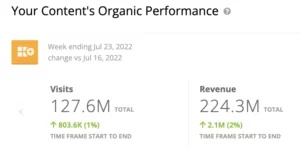
2. Take a look at how this page has been performing over time.
Get a sense of how this page is trending, paying special attention to any drops and gains. Those shifts are the key to understanding what changes you can make that will have an impact.
Tip: Have different global versions of this page on your domain? Create a Content Segment to track them together.

3. Scroll through your team’s activities to see what caused those spikes or dips.
Content Activity Reporting automatically detects changes that you or your team made to your page. Take a look at what actions may have triggered the shift so you know what to repeat or avoid.
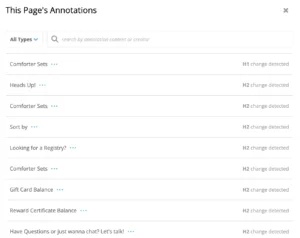
4. Check out how people are finding this page over time.
The Page Details Report shows you what search terms your page ranks for. If you’ve lost visibility for key terms, consider optimizing the page and improving your content.
Tip: Marketing executives love this table. Add it to your reporting workspaces so that they can see the way customers are finding you over time.

5. Improve your rankings for relevant, high-volume search terms.
Use the Keyword Table to see what search terms you are currently visible for. See how much traffic you could gain if you improved your rankings by sorting by MSV.
Tip: If you’re ranking for search terms that aren’t relevant to your content, consider creating a new page better suited for those terms. Imagine you have a women’s tennis shoe page that ranks for “best running shoes.” You could lose half your potential audience—men—once they reach the page!

6. Get more traffic by optimizing your page for new, relevant keywords.
Click the ellipsis “…” and “Research in Explorer” to research new terms. You can bulk up your page with content that targets these new keywords.
Conductor Customer Story: By adding new, relevant search terms to their Wi-Fi calling page, Republic Wireless increased their page’s traffic by 108% and their transactions by 100%.

7. Find new search terms that you didn’t know you were visible for.
Use Explorer to discover keywords that your page is ranking for, but you’re not tracking in the Platform. Start tracking these terms and use them to optimize your existing content or to create new, unique content.
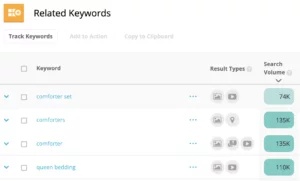
8. Check your link profile.
Use ContentKing to understand the maturity and value of your backlinking and cross-linking positioning. Based on your analysis, consider whether you need to bulk up your internal or external links to this page to improve visibility.

9. Keep track of your success and share it.
Scroll back through Content’s Organic Performance and check out the Insight Stream. Remembering the insights you found most useful. Add those widgets to a workspace and set up reporting for the rest of your team.
